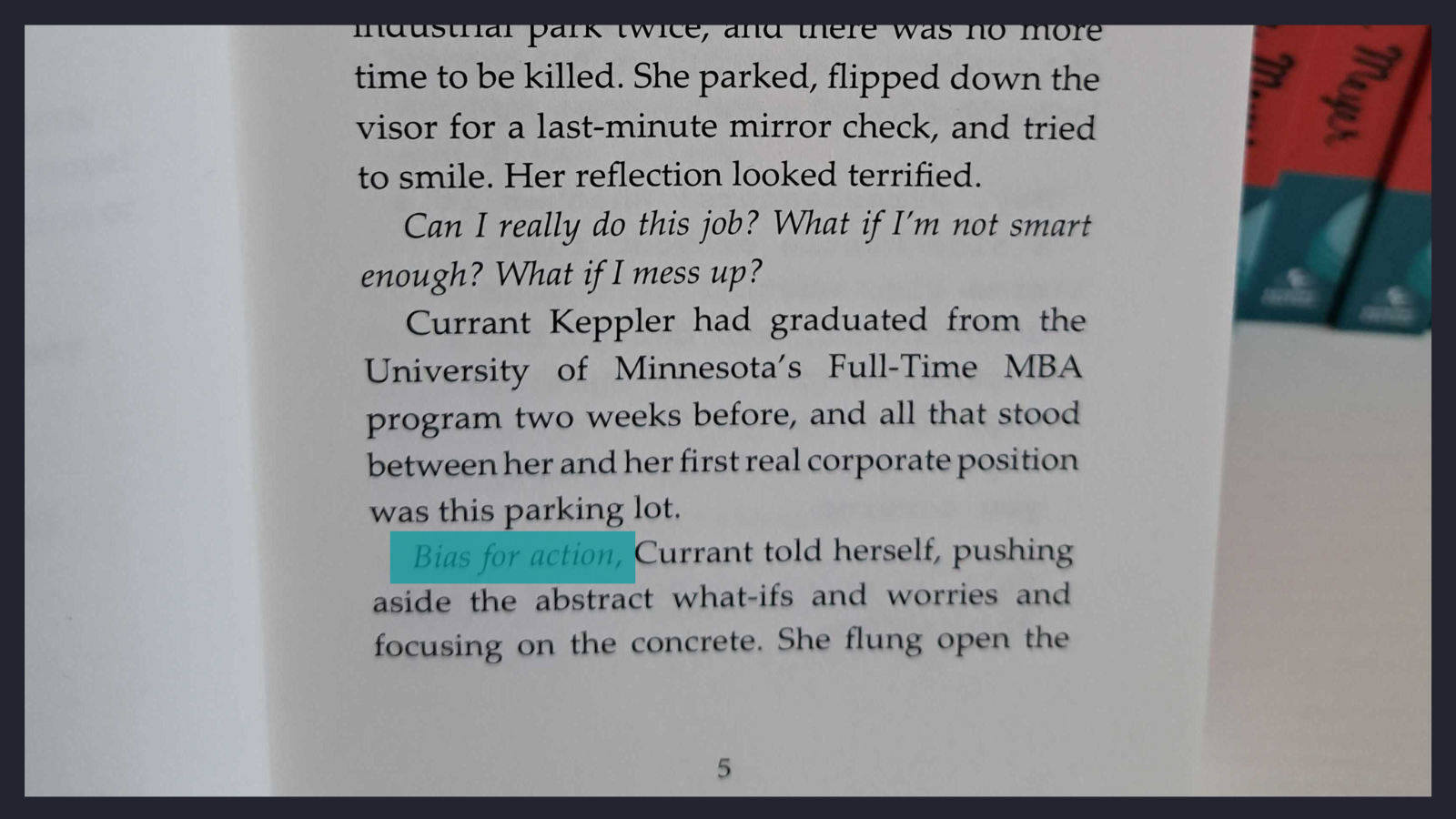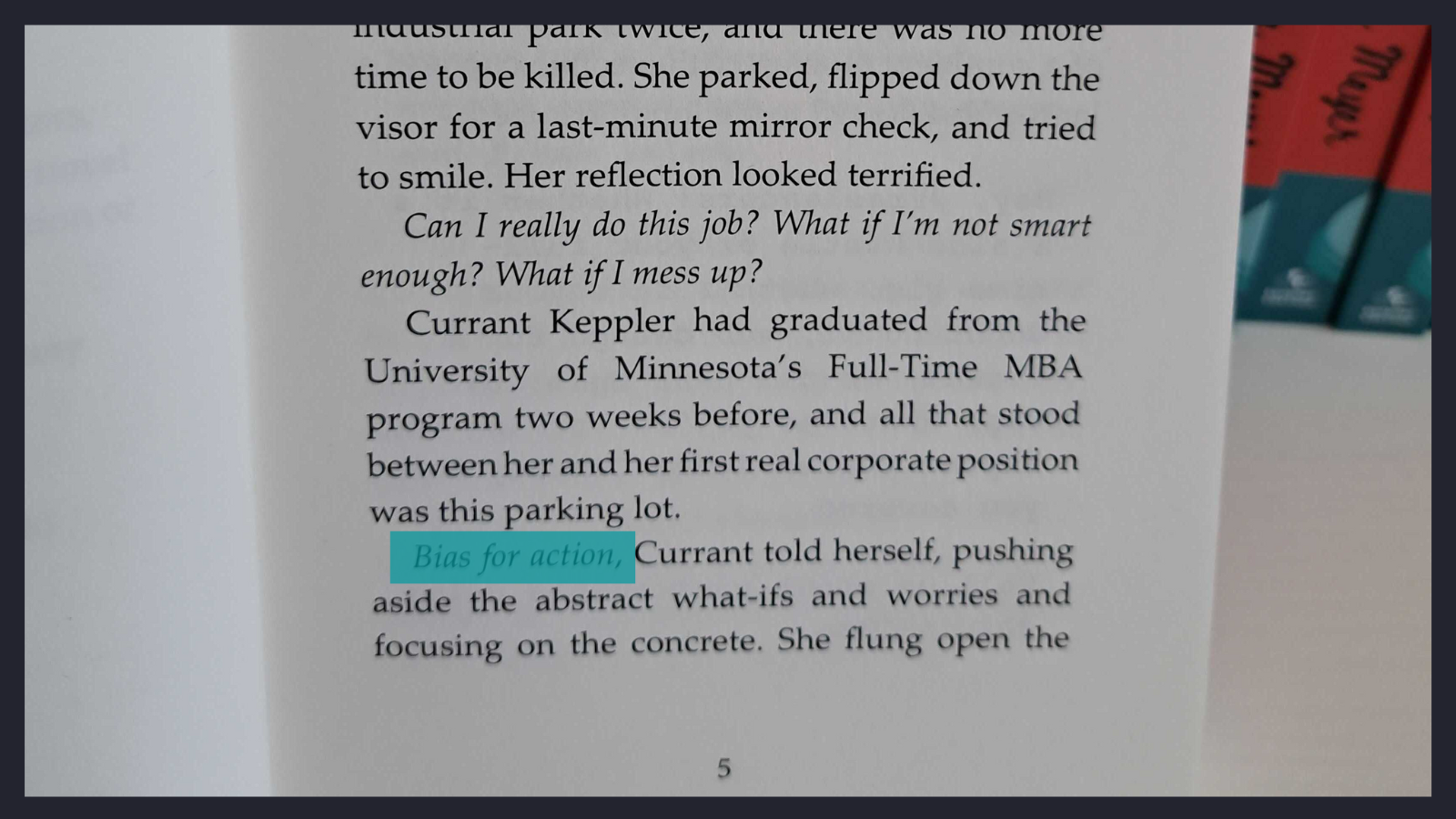
Bias for Action
Focus on the concrete

She had already driven the perimeter of the industrial park twice, and there was no more time to be killed. She parked, flipped down the visor for a last-minute mirror check, and tried to smile. Her reflection looked terrified.
Can I really do this job? What if I’m not smart enough? What if I mess up?
Currant Keppler had graduated from the University of Minnesota’s Full-Time MBA program two weeks before, and all that stood between her and her first real corporate position was this parking lot.
Bias for action, Currant told herself, pushing aside the abstract what-ifs and worries and focusing on the concrete. She flung open the door of her Honda, forcing herself out of the car, and strode purposefully toward her future.
This is the opening scene from Firebrand: A Corporate Elements Mystery, by Megan Preston Meyer, who is me.
The book is about Currant Keppler, a 25-year-old with a fresh MBA who gets her first real job and then has to solve a mystery. It is semi-autobiographical; I got my MBA and then my first real job, and did not have to solve a mystery (hence the ‘semi-’). I did, however, go through a lot of what Currant goes through.
The wild cycling between imposter syndrome and overconfidence? That was me1. There’s a lot of me in Currant, so it’s no surprise that the phrase she uses to psych herself up to get out of the car is a phrase that I use a lot in my life: Bias for Action.
Bias for Action is a reminder that, if you have two alternatives open to you, where one means waiting and the other means doing something, all things being equal, you should do the Something. It’s a catalyst when you’re hesitating, a prod when you’re procrastinating, a bit of courage when something is scary or anxiety-inducing and you really don’t want to do it. It’s a little nudge, Buridan’s Donkey-style, to get you moving in some direction so you don’t just sit there forever and languish.
The fact that I have a book from which I could quote to introduce the concept of Bias for Action was itself made possible by a bias for action1. But this is not one of those Look How Courageous and Driven I Am articles wrapped in a gossamer layer of And You Can Be Too! I’m not abnormally driven—I’m probably 70th-percentile driven—and I’m not a bastion of bravery. Bias for Action is just a really, really helpful tactic.
When I was writing Firebrand, I finished the final draft and then… waited. For, like, six months. I read it, and then reread it. I checked it for typos, even though I had checked it for typos before, seven times, and at least two other people had checked it for typos. There were no typos3… there was only procrastination, perfectionism, and fear.
When I was over-engineering commas and triple-checking internal-dialogue formatting, I was actually protecting myself from the fact that, once Firebrand was in the world, people could read it and hate it and hate me. I was afraid, and that fear made me hesitate; Bias for Action got me moving.
Movement mitigates fear. It doesn’t cure it, but at least it begets actual things to fear, which are easier to deal with than Fear Itself. A two-star review? I’ll get over it. At least I have a book which can be reviewed. And that is due, in large part, to a Bias for Action which kept me moving.
Movement is where things happen. It’s where books get published and businesses get built and goals get accomplished and marathons get run. None of that happens when you’re sitting in a Honda.
Currant doesn’t have it all figured out. She has very little of it figured out. She probably will figure some more of it out, but that will take a couple more books, and even then, she’s limited to what I have figured out.
But she and I do know this: whatever metaphorical parking lot you’re facing, fling that door open and take that first step. Bias for action, you’ll tell yourself. It’s not about not being scared—you’ll still be scared—but at least you won’t be paralyzed.
1 Still is, sometimes, but my character arc has had more time to develop ↑
2 Whoa, Heinlein… ↑
3 Narrator Voice: There were indeed typos, but none that would be found until much, much later ↑
Occasional emails from Megan
I promise not to spam you and I promise not to be boring.






